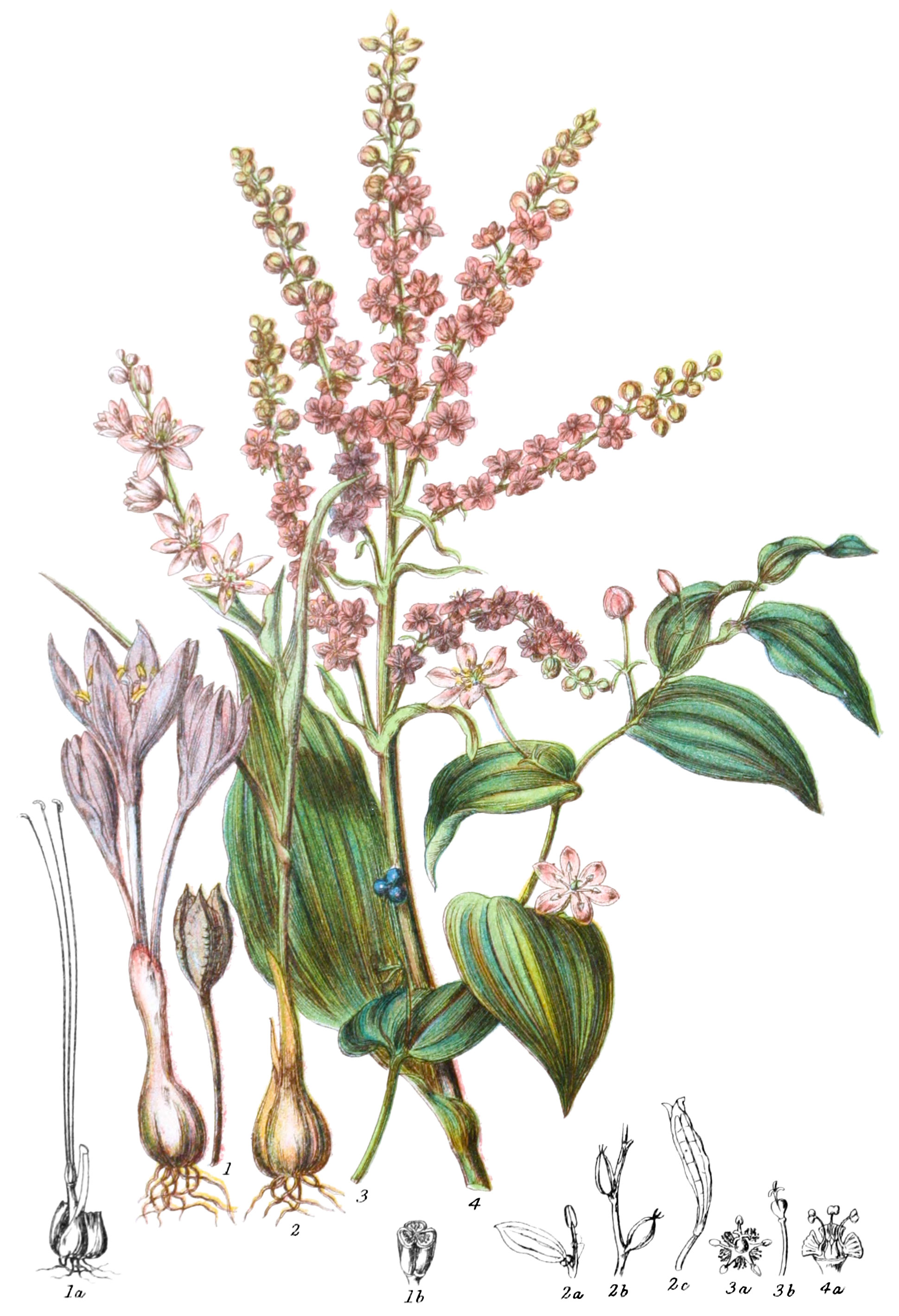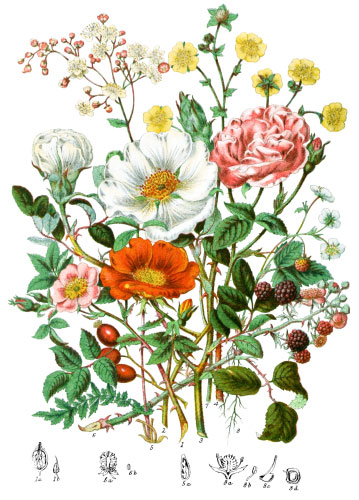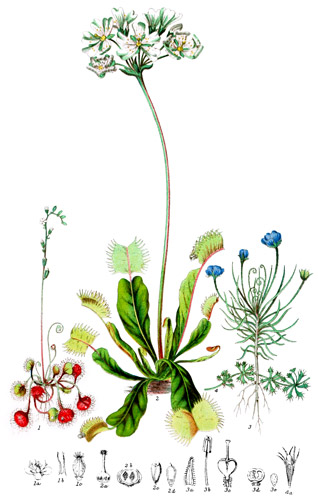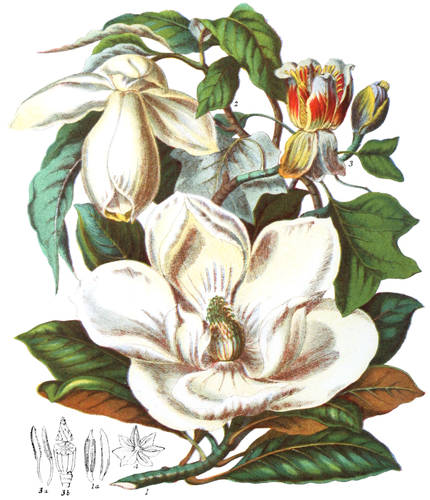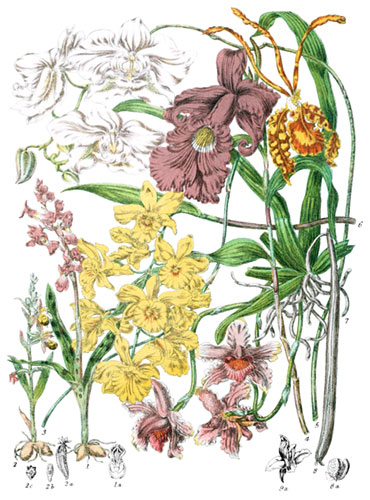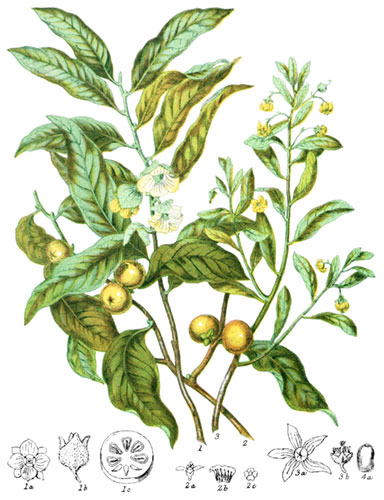Key characteristics
Herbaceous plants, having bulbous, tuberous, or fibrous roots; some are stemless, some have branching or simple stems. The flowers are usually purple, white, or green. The calyx and corolla are similar, free, petal-like, in six divisions, or by partial adhesion tubular. The stamens are six, the anthers turned outwards. The ovary is three-celled, the style tree-parted, the stigmas undivided; the capsule generally separable into three parts. The seeds are numerous, with a membranous covering, and contain dense albumen.
This Tribe has close affinity with Liliaceæ, but is known by the anthers turning outwards, and the three-parted capsule.
Highly poisonous properties exist in these plants.
Select plants in this order
Not all plants listed are illustrated and not all plants illustrated are listed.
- Colchicum by Dioscorides to have derived its name from Colchis, where it grew abundantly. It is one of those plants which produce flowers before leaves, a process only to be effected ty perennial trees, or bulbous or tuberous-tooted plants, and most frequently by the latter. The new plant springs from the side of the root, the upper portion of the spathe or sheath rises out of the ground, and from it emerge three or more flowers in the month of September. After the slender-tubed flowers droop and wither, the seed-vessels lie dormant underground until the following spring, when they grow upwards and the seeds are enabled to ripen, which cannot be accomplished in the earth. A few simple leaves come forth at the same period, and then a pause occurs till the autumnal flowering. As a medicine, Colchicum was known in the time of Hippocrates, and it is still used as a valuable remedy in rheumatism and other illness.
- C. autumnale (1) is frequent in the moist meadows of various parts of England.
- C. variegatum is the species common in Greece, and in our gardens.
- Melanthium is a genus belonging to the Cape of Good Hope; M. junceum (2) has rush-like leaves proceeding from the bulbous root; on the claw of the petal are two glands, full of honey; this was one of the first species brought to England.
- M. eucomoides is a dwarf species: the flowers are seated in the midst of wide leaves; each petal is folded at the base into a tube, from which the large anther protrudes
- Veratrum, said to be named from the black root, contains an alkaline principle called Veratrine, similar to that which exists in Colchicum.
- V. nigrum (4) grows to the height of four or five feet, bearing a branching panicle of flowers, the large leaves clustering around the base of the stem, forming a handsom object in the garden. It has less powerful qualities than V. alum, which is used medicinally, although, in large quantities, poisonous. The virulence of the poisonous juice of these plants appears to differ in various seasons, for it is said that in the poor districts of Europe the peasants eat the roots of Colchicum, when boiled, in autumn.
- A few years ago, a poor woman in Covent Garden market mistook some Colchicum roots for onions, and eating them, was poisoned.
- Kreysigia Cunninghamia (3), named after two entrprising travellers in Australia, is one of the numerous beautiful plants adde dto our stores from that country; the honey-glands are like those of Parnassia.
- Bulbocodium, so called from the rough woolly covering of the bulb, produces its purple flowers, much resembling Colchicum, in the spring season, in Spain.
- Uvularia is a genus of North America an dchina, astringent in its properties.
- The bruised leaves of U. grandiflora are a remedy in the United States for the bite of the rattlesnake.
- The root of Helonias dioica is used medicinally in North America.
- H. frigida of Mexico is poisonous to horses who feed on it.
- Asagrœa officinalis yields the Sabadilla seeds, which in some countries are known as a medicine.
- The most remarkable and beautiful flower of this tribe is Gloriosa superba of the East Indies. The six petals are of a bright orange hue, curled at their edges, and bend backwards, whilst the stamens and pistil hang downwards. The leaves are wide, and terminate in a long point, rolled inwards at the end like a tendril.
- G. simplex, a species of Senegal, has a blue flower, and the leaves are merely sharp-pointed.
Locations
This Tribe is common at the Cape of Good Hope, in Asia, North America, and Europe; it exists in the Tropics of India and Australia, but is most abundant in northern countries.
Legend
- Colchicum autumnale, Meadow Saffron. England.
- Ovary and Pistil.
- Section of Ovary.
- Melanthium junceum, Rush-leaved Melanthium. Cape of Good Hope.
- Stamen and Petal.
- Seed-vessel.
- Seed-vessel of M. uniflorum.
- Kreysigia Cunninghami, Cunningham’s Kreysigia. New Holland.
- Stamen and Pistil.
- Ovary and Pistil.
- Veratrum nigrum, Dark-flowered Veratrum. Siberia.
- Stamens and Ovaries.
Explore more
Posters
Decorate your walls with colorful detailed posters based on Elizabeth Twining’s beautiful two-volume set from 1868.
Puzzles
Challenge yourself or someone else to assemble a puzzle of all 160 botanical illustrations.
